Pachylia ficus
|
|
Updated as per personal communication with Johan van't Bosch (Mato
Grosso, Brazil, September 13), March 2008
Updated as per personal communication with Tony James (Gamboa, Panama; June flight), October 2008
Updated as per personal communication with Jose Monzon (Guatemala); May 2009
Updated as per personal communication with Ezequiel Bustos (Aguas Blancas, Salta, Argentina, 405m); December 2009
Updated as per
AN ANNOTATED CHECKLIST OF THE SPHINGIDAE OF BOLIVIA, December 2009
Updated as per More, Kitching and Cocucci's Hawkmoths of Argentina 2005, December 2009
Updated as per personal communication with Larry Valentine (Itanhandu, Minas Gerais, Brazil, November 2009); December 17, 2009
updated as per personal communication with Gregory Nielsen (Villavicentio, Meta, Colombia, January 15, 2011, 500m); February 6, 2011
Updated as per CATE (Mexico south to northern Argentina and southern Brazil); February 6, 2011
Updated as per personal communication with Ben Trott (Playa del Carmen, Quintana Roo, Mexico); February 27, 2012; January 9, 2013
Updated as per personal communication with Elisabet Mercado, Mexico City, Mexico, September 5, 2012
Updated as per "A Hawk Moths fauna of southern Maranhao state, Brazil, ... "; NEVA: Jahrgang 34 Heft 3 November 2013; via Jean Haxaire; April 5, 2014
Updated as per personal communication with Sergio D. Rios Diaz in CAT�LOGO DE LOS SPHINGIDAE (INSECTA: LEPIDOPTERA) DEPOSITADOS EN
EL MUSEO NACIONAL DE HISTORIA NATURAL DEL PARAGUAY; sent to me in July 2014 by Sergio D. Rios Diaz.
Updated as per personal communication with Ezequiel Bustos (Shilap revta. lepid. 43 (172) diciembre, 2015, 615-631 eISSN 2340-4078 ISSN 0300-5267), January 4, 2016
Updated as per personal communication with Richard Land (Pockwood Pond, Tortola, British Virgin Islands, January 2, 2016), February 8, 2016
Updated as per personal communication with Diogo Luiz (adult moth, Nova Iguacu, Rio de Janeiro, Brazil, December 4, 2016), December 28, 2016
Updated as per personal communication with Wolfgang Walz (, larva, Pedro Leopoldo, Minas Gerais, Brazil, December 26, 2016), December 28, 2016
Updated as per personal communication with Bruno Moraes, (pupae, Belo Horizonte, Minas Gerais, Brazil, December 28, 2016), December 28, 2016
Updated as per personal communication with Alves Tavares, (larva to pupa to moth, Parnaiba, Piaui, Brazil, Febrary 22 - March-21, 2019), March 21, 2019
Updated as per personal communication with Fabricio Vilela (mature larva, Foz do Iguacu, Parana, Brazil, April 9, 2019); April 9, 2019
Updated as per personal communication with Joao Amarildo Ranguetti (mature larva, Massaranduba, Santa Catarina, Brazil, January 3, 2019); April 9, 2019
Updated as per personal communication with Galerita Janus (Pachylia ficus, Cerro Jefe, Panama, Panama, July, 2016); March 13, 2020
Updated as per personal communication with Frank and Anna West (Madre de Dios and Junin, Peru; Rondonia, Brazil; Izabal, Guatemala); January 20, 2021
|
Pachylia ficus
Fig Sphinx
Linnaeus, 1758
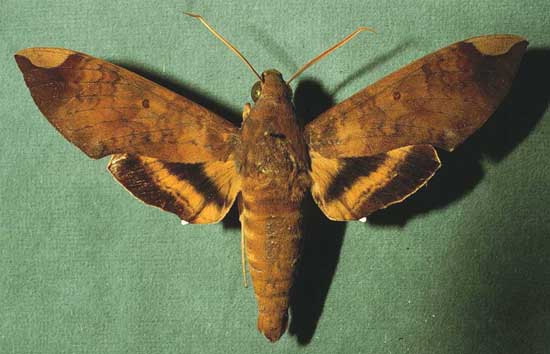
Pachylia ficus male courtesy of Dan Janzen.
This site has been created by Bill Oehlke.
Comments, suggestions and/or additional information are welcomed by Bill.
TAXONOMY:
Family: Sphingidae, Latreille, 1802
Subfamily: Macroglossinae, Harris, 1839
Tribe: Dilophonotini, Burmeister, 1878
Genus: Pachylia Walker, 1856 ...........
Species: ficus Linnaeus, 1758
|
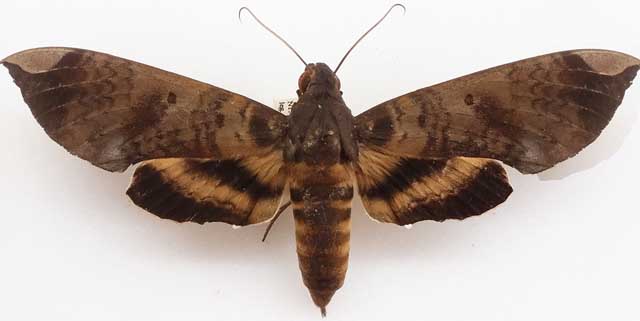
Pachylia ficus female, 138mm, near Morales, Izabal, Guatemala,
August, 2006, 2200ft., courtesy of Frank & Anna West.
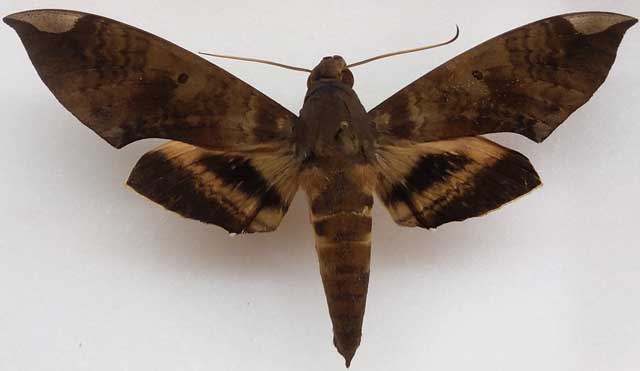
Pachylia ficus male, 118mm, Pampa Hermosa Lodge, Junin, Peru,
December, 2008, 4000ft, courtesy of Frank & Anna West.
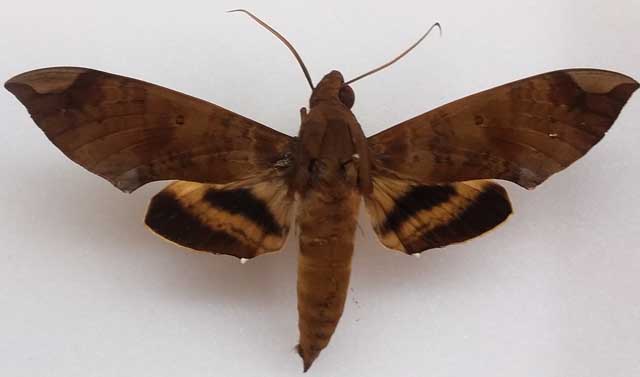
Pachylia ficus male, 115mm, Atalaya, Madre de Deos, Peru,
November, 2007, 1600ft, courtesy of Frank & Anna West.
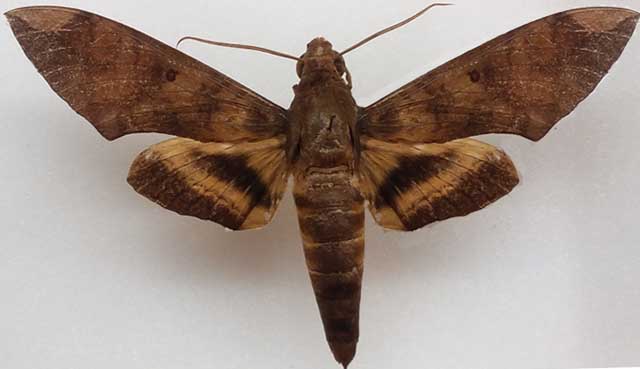
Pachylia ficus male, 111mm, Frenza Rancho Grande, Rondonia, Brasil,
August, 1993, courtesy of Frank & Anna West.
DISTRIBUTION:
The Fig sphinx, Pachylia ficus
(Wing span: 4 3/4 - 5 1/2 inches (12 - 14 cm; 111-145mm; males smaller than females)) flies in all biotypes from
Uruguay (EB);
Brazil: Paraiba; Piaui: Parnaiba (AT); Mato Grosso; Minas Gerais: Belo Horizonte (BM); southern Maranhao; Santa Catarina: Massaranduba (JAR);
Parana: Foz do Iguacu (FV); Rondonia: Frenza Rancho Grande (F&AW); all Brazilian states (JH)
Peru: Madre de Dios: Atalaya; Junin: Pampa Hermosa Lodge (F&AW);
Bolivia: Santa Cruz, Cochabamba, La Paz;
Paraguay: Asuncion; Concepcion; paraguari; Canindeyu;
Argentina: Buenos Aires, Cordoba, Corrientes, Entre Rios, Chaco (EB), Formosa, Jujuy, La Rioja, Salta (EB), Tucuman, Misiones;
Colombia: Meta (GN)) north;
through Central America:
Panama: Chiriqui: Mount Totumas, 1880m (GJ)
to Mexico: Quintana Roo (BT), probalby throughout Mexico;
Guatemala: Izabal (F&AW); and the West Indies to Florida,
southern Texas, and southern Arizona. It occasionally strays as far north as Indiana and Pennsylvania.
Greg Nielsen sends the image of this very "green" specimen from Colombia.
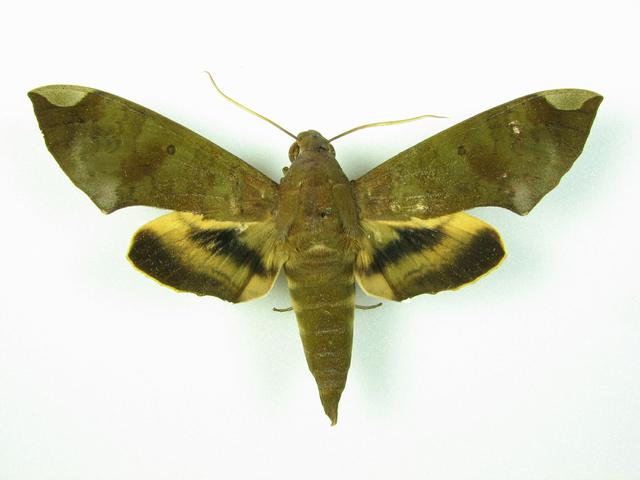
Pachylia ficus, Villavicentio, Km 13 via AcaciasMeta, Colombia,
04�03�55.0 N 073�41�87.0 W, 500m, January 15, 2011, lfw=55mm, courtesy of Gregory Nielsen.
Visit Pachylia ficus, Brownsville, Cameron County, courtesy of Gus A. Rentfro.
Visit Pachylia ficus, Itanhandu, Minas Gerais, Brazil, November 2009, courtesy of Larry Valentine.
The upperside of the forewing is orangish brown with a paler patch along the costa at the tip. The upperside of the
hindwing is orange to orangish brown with a black outer border, a black median band, and a white spot on the outer margin near the body.
Pachylia ficus Yasuni, Ecuador, (September 10, 2002 - 11:55 PM) in typical resting pose, courtesy of Steve Graser. |
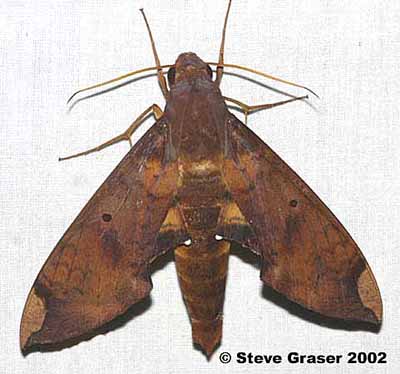 |
FLIGHT TIMES:
There are several flights throughout the year in the tropics, peninsular Florida, and southern Texas. Galerita Janus reports a July
flight on Mount Totumas, Chiriqui, Panama.
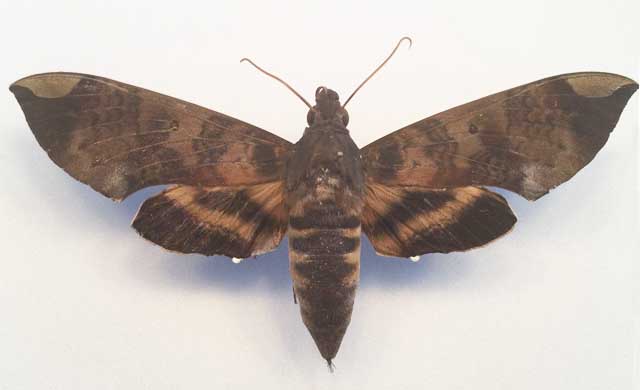
Pachylia ficus, 145mm, Cerro Jefe, Panama, Panama,
July 5, 2016, 900m, courtesy of Galerita Janus, id by Bill Oehlke>
Johan van't Bosch reports a September flight in Cristalino Jungle Lodge, Mato Grosso, Brazil.Larry Valentine reports a November flight in Itanhandu, Minas Gerais,
Brazil. Tony James reports a June flight in Panama. Galerita Janus reports an early July flight in Panama.
Ezequiel Bustos reports it from Argentina: Salta (405m).
Alexander von Buldring reports a February flight in Paraiba, Brazil.
Ben Trott reports a December 13, 2012, eclosion of stock from Playa del Carmen, Quintana Roo, Mexico, about three weeks after pupation.
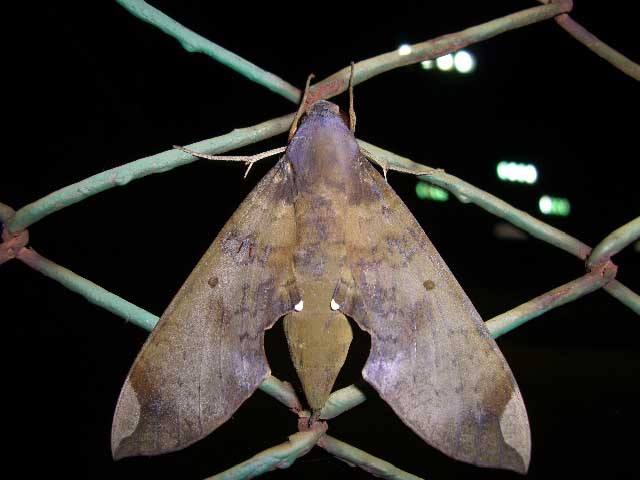
Pachylia ficus, Joao Pessoa, Paraiba, Brazil,
40m, February 26, 2009, 8:40pm, coourtesy of
Alexander von Buldring.
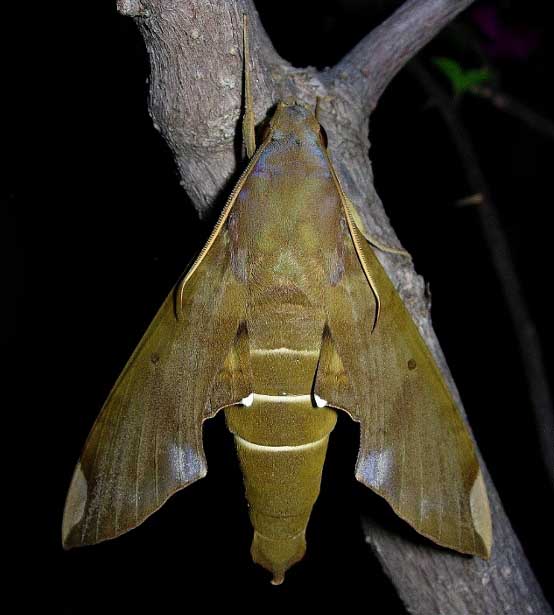
Pachylia ficus female, Playa del Carmen, Quintana Roo, Mexico,
130mm, December 13, 2012, courtesy of Ben Trott.
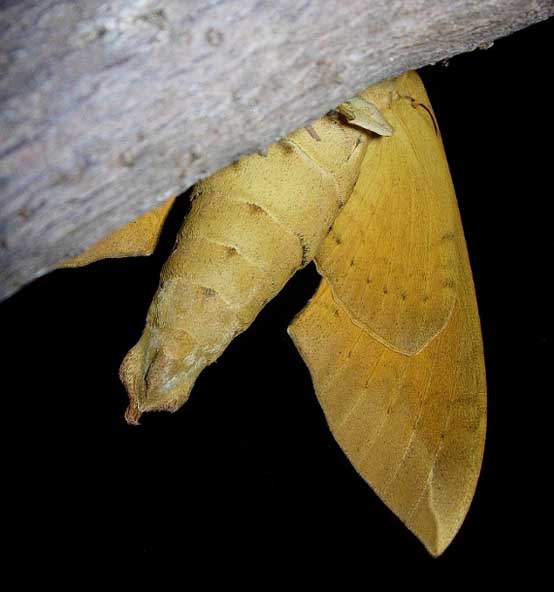
Pachylia ficus female (verso), Playa del Carmen, Quintana Roo, Mexico,
130mm, December 13, 2012, courtesy of Ben Trott;
eclosion two and a half to three weeks from pupation date.
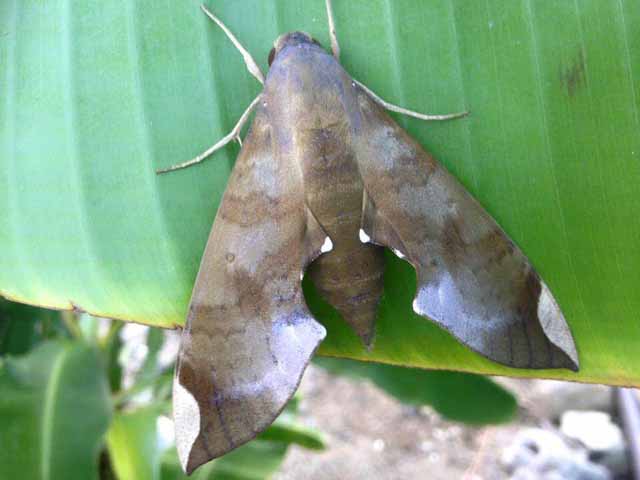
Pachylia ficus Pockwood Pond, Tortola, British Virgin Islands,
January 2, 2016, courtesy of Richard Land.
Adult like to nectar from flowers, including Asystasia gangetica, starting just before sunset.
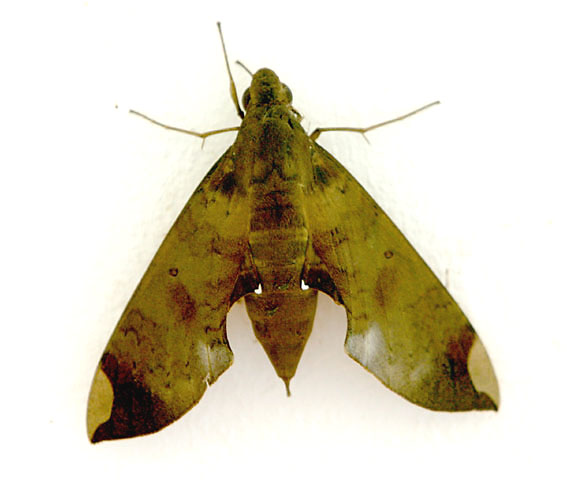
Pachylia ficus, female, Bonaire, January 28, 2005,
courtesy of Abraham Potappel, via Diane McIntyre.
ECLOSION:
Larvae pupate in thin walled cocoons under leaf
litter.
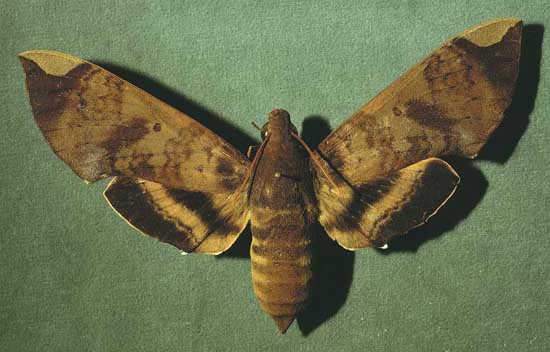
Pachylia ficus female courtesy of Dan Janzen.
SCENTING AND MATING:
Females call in the males with a pheromone released from a gland at the tip of the abdomen.
EGGS, LARVAE, PUPAE:
Females feed and lay eggs on fig leaves, especially Strangler Fig (Ficus aurea). Ficus carica, Ficus microcarpa, Ficus religiosa,
Ficus pumila, Ficus gamelleira, Ficus prinoides, Ficus pumila and Artocarpus integrifolia are also listed as hosts.
Jean Haxaire: Ficus spp. and other Moraceae. In Costa Rica, on Ficus sp., Brosimum sp., Castilla sp., and Maclura sp."
Larvae pupate in cocoons spun amongst leaf litter.
There are several colour morphs.
Image, St. Croix, U.S. Virgin Islands, April 2004, courtesy of Lee
Snyder. |
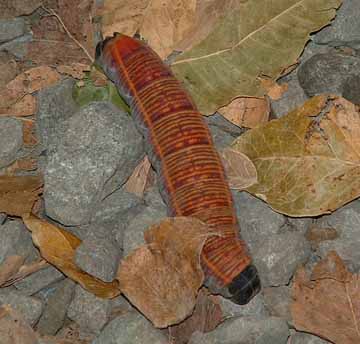
|
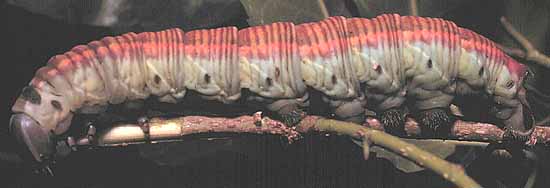

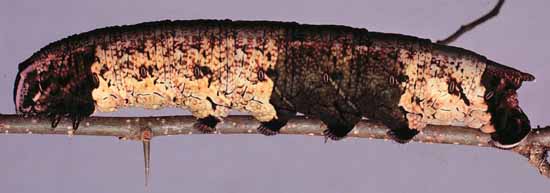

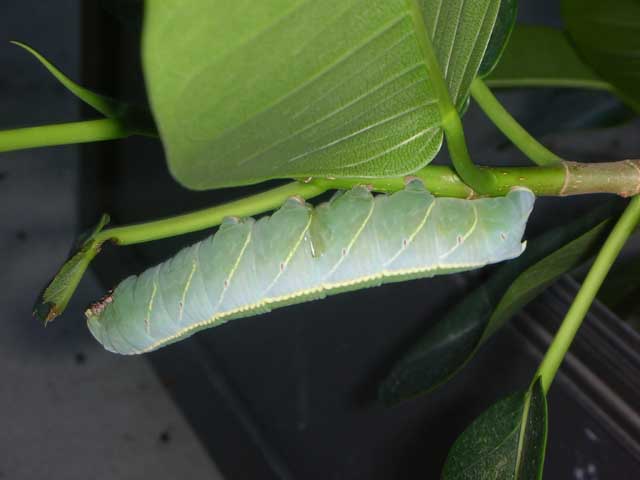
Pachylia ficus, Pompano Beach, April 12, 2007, courtesy of Chris Marino.
Visit additional Pachylia ficus images by Chris.
Ben Trott sends the images below and writes from Quintana Roo, Mexico, "Pachylia ficus (x4), very easy to find due to their size, but also highly parasited, 3 out of 4 died before
pupating. I came across three colour morphs, brown, green, & blue/green. This appears to depend on which Ficus they feed on: the brown larva was found on a
Ficus aurea with many leaves with brown patches.
All larvae were heavily parasited, including a female which managed to pupate, two weeks later, about ten big black parasitic flies broke their way out of the pupa."
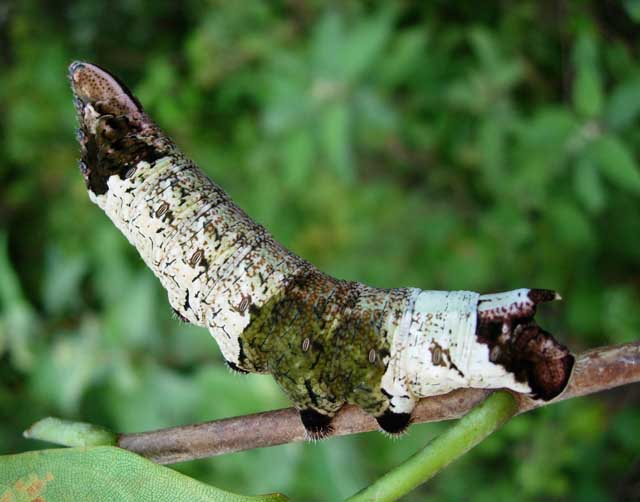
Pachylia ficus fifth instar (brown form), Playa del Carmen, Quintana Roo, Mexico,
courtesy of Ben Trott.
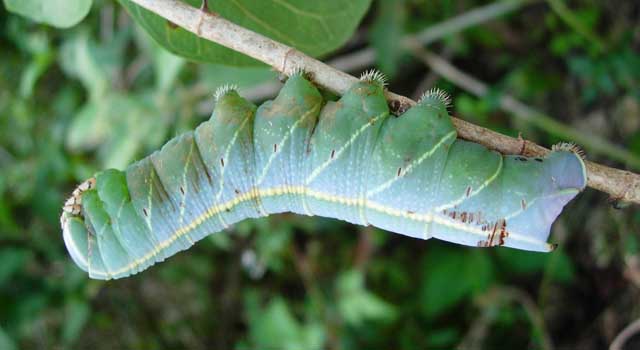
Pachylia ficus fifth instar (blue-green form), Playa del Carmen, Quintana Roo, Mexico,
courtesy of Ben Trott.
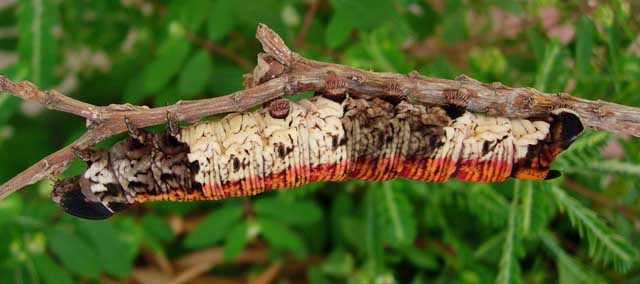
Pachylia ficus fifth instar, Playa del Carmen, Quintana Roo, Mexico,
courtesy of Ben Trott.
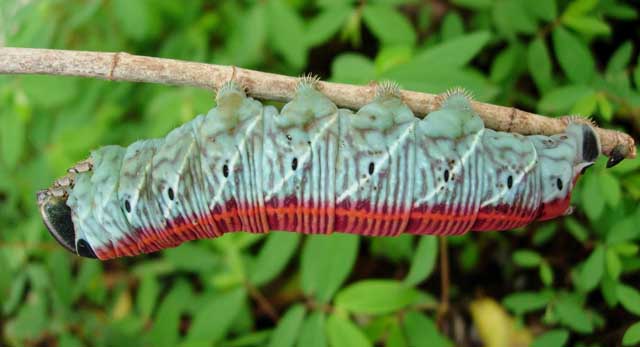
Pachylia ficus fifth instar prepupal, Playa del Carmen, Quintana Roo, Mexico,
courtesy of Ben Trott.
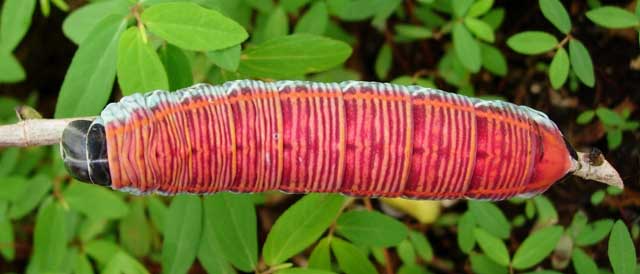
Pachylia ficus fifth instar prepupal, Playa del Carmen, Quintana Roo, Mexico,
courtesy of Ben Trott.
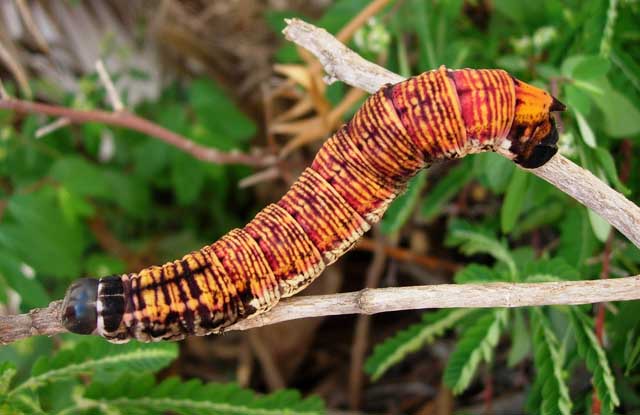
Pachylia ficus fifth instar prepupal, Playa del Carmen, Quintana Roo, Mexico,
courtesy of Ben Trott.
On September 5, 2012, Elisabet Mercado sent me the following image from Mexico City, Mexico, and asked for identification help and help with possible care of larva.
I replied:
"Elisabet,
"I am pretty sure it is larva of Pachylia ficus, the Fig Sphinx.
You can try offering it some fig leaves, still affixed to twig, but I suspect it is done feeding and is ready to pupate.
My Mexico Sphingidae site is at
http://www.silkmoths.bizland.com/Sphinx/Mexsphinx.htm
"Here is an article that explains how to care for found larvae http://www.silkmoths.bizland.com/ManducasextaAugust2008tw.htm
The species is different and the food plants are different, but general procedures are same with same result.
Good luck. Please send a picture of the adult moth when it emerges, probably in three to five weeks.
"Bill Oehlke"
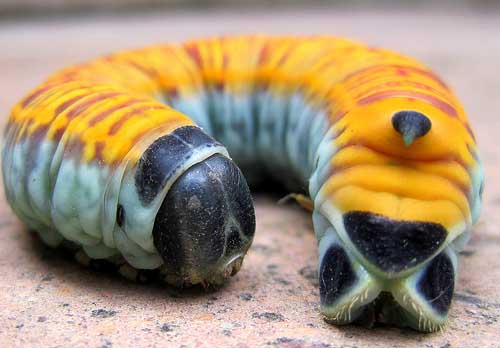
Pachylia ficus fifth instar, Mexico City, Mexico,
September 5, 2012, courtesy of Elisabet Mercado.
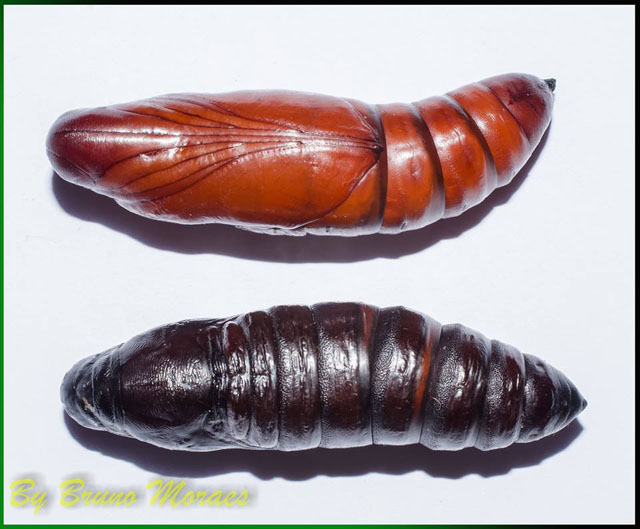
Pachylia ficus pupae, Belo Horizonte, Minas Gerais, Brazil,
December 28, 2016, courtesy of Bruno Moraes.
Alves Tavares writes regarding a female Pachylia ficus "Created her from 22/02/2019 (green larva) to today 21/03/2019 (adult moth).
Collected the caterpillar in a Ficus pumilla on the wall of my house in Parna�ba, Piau�, Brazil. I was feeding with leaves of this creeper.
I was impressed by the amount of feces that passed from fifty per day! On the sixth day she changed the color of green to orange with blue and stopped feeding.
Two days later turned into pupa. The adult emerged today after 17 days, took the photos and released in my backyard!"
Visit additional Pachylia ficus images from Brazil, including those from Alves Tavares.
Use your browser "Back" button to return to the previous page.
This page is brought to you by Bill Oehlke and the
WLSS. Pages are on space rented from Bizland. If you would like
to become a "Patron of the Sphingidae Site", contact Bill.
Please send sightings/images to Bill. I will do my best to respond to
requests for identification help.
Enjoy some of nature's wonderments: Saturniidae cocoons.
Cocoons of the giant silkmoths may be purchased in the fall and winter. Big and beautiful giant silk moths will emerge in spring/summer.
Read Actias luna rearing article. Additional online help available.



























